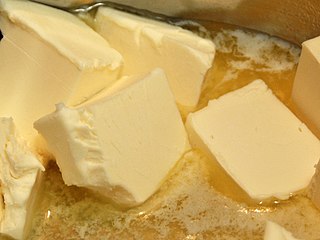
Butter is a dairy product made from the fat and protein components of churned cream. It is a semi-solid emulsion at room temperature, consisting of approximately 80% butterfat. It is used at room temperature as a spread, melted as a condiment, and used as a fat in baking, sauce-making, pan frying, and other cooking procedures.
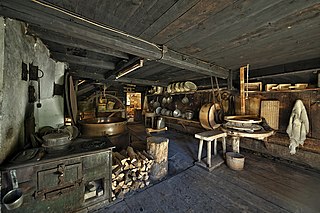
A dairy is a place where milk is stored and where butter, cheese and other dairy products are made, or a place where those products are sold. It may be a room, a building or a larger establishment. In the United States, the word may also describe a dairy farm or the part of a mixed farm dedicated to milk for human consumption, whether from cows, buffaloes, goats, sheep, horses or camels.
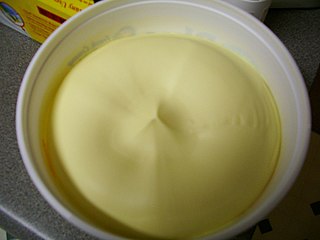
Margarine is a spread used for flavoring, baking, and cooking. It is most often used as a substitute for butter. Although originally made from animal fats, most margarine consumed today is made from vegetable oil. The spread was originally named oleomargarine from Latin for oleum and Greek margarite. The name was later shortened to margarine.

Annatto is an orange-red condiment and food coloring derived from the seeds of the achiote tree, native to tropical parts of the Americas. It is often used to impart a yellow or orange color to foods, but sometimes also for its flavor and aroma. Its scent is described as "slightly peppery with a hint of nutmeg" and flavor as "slightly nutty, sweet and peppery".

Cornelis Lely was a Dutch politician of the Liberal Union (LU) and civil engineer. He oversaw the passage of an act of parliament authorising construction of the Zuiderzee Works, a huge project – designed to his own plans – that turned the Zuiderzee into a lake and made possible the conversion of a vast area of former seabed into dry land.

Antonius Johannes Jurgens, also known as Anton Jurgens was a Dutch businessman.
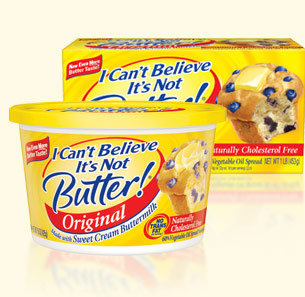
I Can't Believe It's Not Butter! is a brand of a spreadable emulsion of vegetable oil in water with butter flavor produced by Upfield and marketed as a substitute for butter.

A cheese sandwich is a sandwich made with cheese on bread. Typically semi-hard cheeses are used for the filling, such as Cheddar, Red Leicester, or Double Gloucester. A Guardian article called the cheese sandwich a "British lunchtime staple". Using a sandwich toaster or frying pan can transform the cheese sandwich into a cheese toastie.

Butter sculptures are three-dimensional works of art created with butter, a dairy product made from the fat and protein components of churned cream. The works often depict animals, people, buildings and other objects. They are best known as attractions at state fairs in the United States as lifesize cows and people, but can also be found on banquet tables and even small decorative butter pats. Butter carving was an ancient craft in Tibet, Babylon, Roman Britain and elsewhere. The earliest documented butter sculptures date from Europe in 1536, where they were used on banquet tables. The earliest pieces in the modern sense as public art date from ca. 1870s America, created by Caroline Shawk Brooks, a farm woman from Helena, Arkansas. The heyday of butter sculpturing was about 1890–1930, but butter sculptures are still a popular attraction at agricultural fairs, banquet tables and as decorative butter patties.

Hippolyte Mège-Mouriès was a French chemist and inventor who is famous for his invention of margarine.
The Newfoundland Margarine Company was Canada's first oleomargarine manufacturing company, and a leading producer in the Dominion of Newfoundland and after 1949, the province of Newfoundland and Labrador. It was founded by Sir John Chalker Crosbie in 1925 and was one of three margarine plants established in Newfoundland during the early 20th century. With the expertise of George Ehlers, a Danish chemist, the Crosbie family grew the firm into the largest margarine manufacturing firm in Newfoundland. The Newfoundland Butter Company through acquisition and merger over the years with the other two manufacturing plants was eventually sold to Lever Brothers of England in 1937 and became a subsidiary of Lever Brothers of Canada.

Harry Lintsen is a Dutch scientist. He is professor in history of technology at Eindhoven University of Technology, Netherlands, and researcher on microplastics.
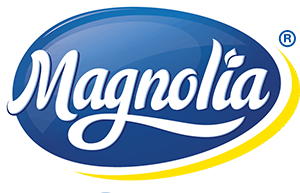
Magnolia is a food and beverage brand owned by San Miguel Corporation (SMC) and used by its various subsidiaries. The brand was commercially established by SMC as an ice cream brand in 1925.
Nuttelex is an Australian manufacturer of margarine. First manufactured in 1932, its namesake brand is the oldest brand of margarine in Australia.

Antoon Jurgens (1805-1880) was a Dutch merchant and industrialist. He founded a butter company that grew to be one of the largest butter and margarine companies in Europe. His company was instrumental in the formation of Margarine Unie which, in 1930, merged with Lever Brothers to form Unilever.

Vegan cheese is a category of non-dairy, plant-based cheese analogues. Vegan cheeses range from soft fresh cheeses to aged and cultured hard grateable cheeses like plant-based Parmesan. The defining characteristic of vegan cheese is the exclusion of all animal products.

Johanne (Hanne) Ane Margrethe Nielsen was a Danish farmer who may have invented Havarti cheese. In the 1800s, Nielsen traveled around Europe to learn about cheesemaking. Her farm was named Havarthigaard and was close to Copenhagen. After returning from her travels, she developed the technique to create a new type of cheese. She was also a teacher, writer, and an accountant for the profit made from her butter and cheese. Her butter and cheese were served to royal families, including a cheese made with cumin that was served to King Christian IX of Denmark. She was denied membership of the Royal Danish Agricultural Society although she had sought the assistance of dairy scientist Thomas Segelcke. Despite being skeptical of female accountants, Segelcke included her accounting method in a book he published.
Upfield Holdings B.V. is a Dutch food company owning multiple brands of margarine, food spreads, and plant-based foods, including Flora and Blue Band. It states that it is the largest plant-based consumer packaged goods company in the world, operating in 95 countries.

The Maypole Dairy Company or Maypole Dairies were an early chain of British dairies who rose to be the biggest employer in Britain and are also noted as the first people to promote the widespread use of margarine as an alternative to butter, originally under the name of Butterine but following legal action protecting this name was known as margarine from 1887.
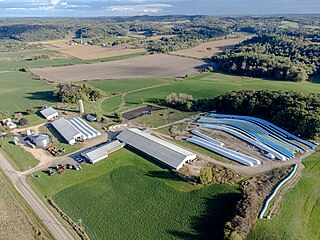
Dairy is a major industry in the state of Wisconsin. Being known for its dairy production, the state is often called "America's Dairyland." The industry is prominent in official state symbols—being displayed on the state's license plates, state's slogan, and on the state quarter.
![The Rijkszuivelstation [nl] in Leiden, which was for many years the location of laboratory research and testing required by the Boterwet Vreewijkstraat 12a.JPG](http://upload.wikimedia.org/wikipedia/commons/thumb/7/76/Vreewijkstraat_12a.JPG/220px-Vreewijkstraat_12a.JPG)

















